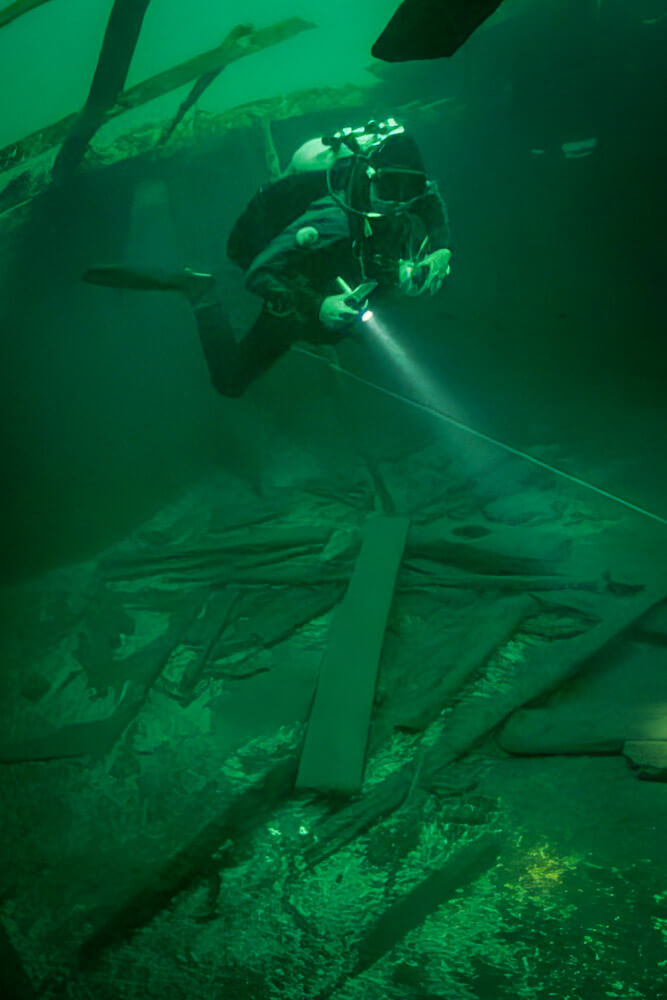Mine I


This course is the first stage in the TDI Mine Diver Development Program and is an introduction to the basic principles of mine diving utilizing a single primary guide line. This introduction is not intended to train divers for all facets of mine diving. The objective of this course is the perfection of skills taught in the TDI Cavern Diving Program, in addition to the adoption of additional techniques and procedures required for elementary mine dives. This course may be combined with TDI Mine Diver Level II at the discretion of the instructor.This course uses the same principles and techniques as the TDI Intro to Cave Course, including utilizing the same training materials and equipment. However, dual certification is not permitted and graduates wishing to dive in caves must complete the TDI Intro to Cave Course.
Interested?
Who this course is for:
Cavern divers who are interested in learning techniques for diving in flooded mines.
Course prerequisites:
- Minimum age 18
- Certified TDI Cavern Diver or equivalent
What you can expect to learn:
The following topics must be covered during this course:
- Policy for mine and cave diving
- Gas matching procedures and management to include dissimilar volumes
- Psychological considerations
- Equipment considerations
- Cylinder options
- Regulator options
- Buoyancy compensator device (BCD)/harness options
- Reel options
- Proper weighting
- Equipment configurations
- Communication
- Hand signals
- Light signals
- Touch contact signals
- Swimming techniques
- Body posture / trim
- Buoyancy control and rebreather weighting
- Line following techniques
- Propulsion techniques
- Physiology
- Breathing techniques
- Stress management
- Mine environment
- Types of mines
- Geology
- Structure
- Hazards
- Local access requirements
- Land owner relations
- Conservation
- Problem solving
- Accident analysis
- Review of dive tables and decompression theory
- Mine and cave diving etiquette
Skills you will have to demonstrate:
All of the following information must be determined/obtained and utilized in dive planning:
- What material(s) were extracted from the mine and by what method(s)
- Were toxic solutions or substances used or created during the extraction process and is there a risk of such substance(s) remaining or of any general pollution – If so, ascertain which location(s)
- Obtain a detailed map of the mine from the mining company or whoever is responsible for the site
- Are there any known or potentially collapsible tunnels
- All known access and egress points from the mine, their depths and possible emergency traverses to other exits
- Type(s) of sediment in the mine
- Type of ceiling supports; i.e. wooden or metal and how to detect signs of wear, type of debris left in the mine
- All possible entanglement points
- Location, size and depth of vertical extraction shafts
- Points that could damage divers’ delicate equipment such as lines, dry suits, etc
- Line options
- How to evaluate the stability of a passage
- Existing collapse points
- Special equipment requirements
- Type of entry/exit
- How to properly:
- Deploy a guideline
- Follow a guideline
- Use of safety reel in:
- Lost diver procedures
- Lost line drill
- Demonstrate
- Adequate pre-dive planning
- Equipment check and equipment matching
- Bubble check
- Specialized propulsion techniques in varying types of flow
- Proper buoyancy control
- Proper body posture
- Proper stress analysis (detection and management)
- Properly deploy a guideline
- Properly use line markers
- Properly follow a guideline with eyes open and closed, simulating loss of visibility
- Air share with a buddy with eyes open, following the guideline
- Air share with a buddy with lights off, eyes closed and use touch contact, following the guideline
- Remove and replace mask while in contact with guideline
- Demonstrate light/hand -signals and touch contact
- Conservation and awareness techniques
- Referencing as back-up navigation
- Demonstrate adequate anti-silting techniques
- Simulate a primary light failure, and use back light to exit the mine
- Demonstrate lost line and lost diver drills
- Identify and avoid potential hazard, entanglement and collapse points
What’s in it for you:
Upon successful completion of this course, graduates may engage in single guideline mine diving activities without direct supervision, provided the graduates adhere to the following limits:
- Penetration is limited to 1/3 of a single diving cylinder, or 1/6th if using double cylinders
40 metres/130 feet maximum depth - No decompression diving
- Maintain a continuous guideline
- Proper mine diving equipment is used
- Upon successful completion of this course, graduates are qualified to enroll in TDI Mine Diver Level II
Minimum requirements:
- Satisfactorily complete the TDI Intro Cave Diver Course written examination
- Perform all land drills and mine dive requirements safely and efficiently
- Demonstrate mature, sound judgment concerning dive planning and execution
- Maintain an appropriate level of awareness and respect for the mine environment
- Log all dives